Pallavi Mehra • 23 Apr 2025
Parents Beware! Harmful Toxins Found In Kids’ Mattresses Could Affect Brain Development

Parents Beware! Harmful Toxins Found In Kids’ Mattresses Could Affect Brain Development (Image Credits: iStock)
Parents often go the extra mile to make sure their babies are safe and healthy. But what if the very place where your baby spends most of their time—sleeping peacefully in their crib—could actually be exposing them to harmful chemicals?
Two recent studies have revealed a surprising and concerning issue: many children's mattresses may be releasing substances that can affect a baby’s brain development and overall health. The findings, published in Environmental Science and Technology Letters, suggest that the materials used in some children's mattresses may be doing more harm than good.
In the first study, researchers tested the air in 25 children's bedrooms. The children were between 6 months and 4 years old, and the air samples were taken near their beds. What the researchers found was worrying—high levels of chemicals like phthalates and flame retardants around the sleeping area. These substances are known as hormone disruptors, meaning they can interfere with the body’s natural hormones.
Hormone-disrupting chemicals have been linked to several developmental problems in children, including learning difficulties, lower IQ, behaviour issues, and memory problems. Since young children are still growing—especially their brains—they’re much more sensitive to these harmful effects.
The second study looked at 16 newly bought children’s mattresses. Researchers wanted to see what would happen when these mattresses were warmed and pressed down, similar to when a child lies on them. Unsurprisingly, the pressure and heat caused the mattresses to release even more chemicals into the air.
“Sleep is essential for babies and toddlers—it’s when a lot of brain development happens,” said Professor Miriam Diamond from the University of Toronto, who led the research. “But our studies show that the very place where children sleep could be exposing them to harmful compounds.”
So, why are babies especially at risk?
- Their brains and bodies are still developing.
Even though this research was based in Canada, most of the mattresses tested were made from materials imported from the US, Mexico, or other countries. That means this issue likely affects baby mattresses across North America.
Arlene Blum, director of the Green Science Policy Institute, added that many of these flame retardants aren’t even required anymore. “They don’t have proven fire safety benefits, yet they’re still found in children’s mattresses,” she said. “It’s concerning because they can affect how well children learn and develop.”
What Can Parents Do?
While experts push for stricter rules and safer mattress production, there are simple steps parents can take to reduce exposure:- Keep the bed simple – Avoid too many pillows, toys, or blankets
Get Latest News Live on Times Now along with Breaking News and Top Headlines from Health and around the world.